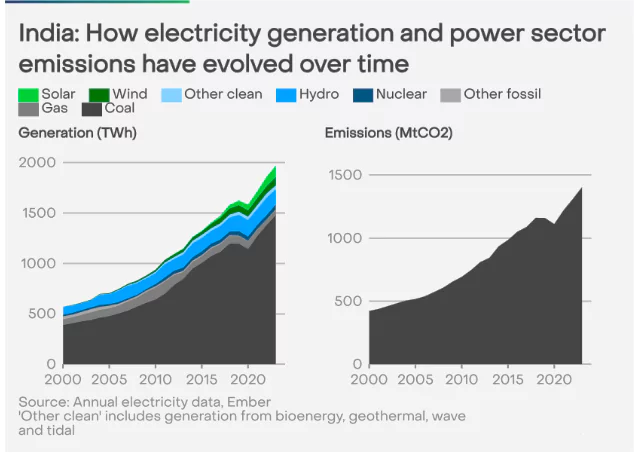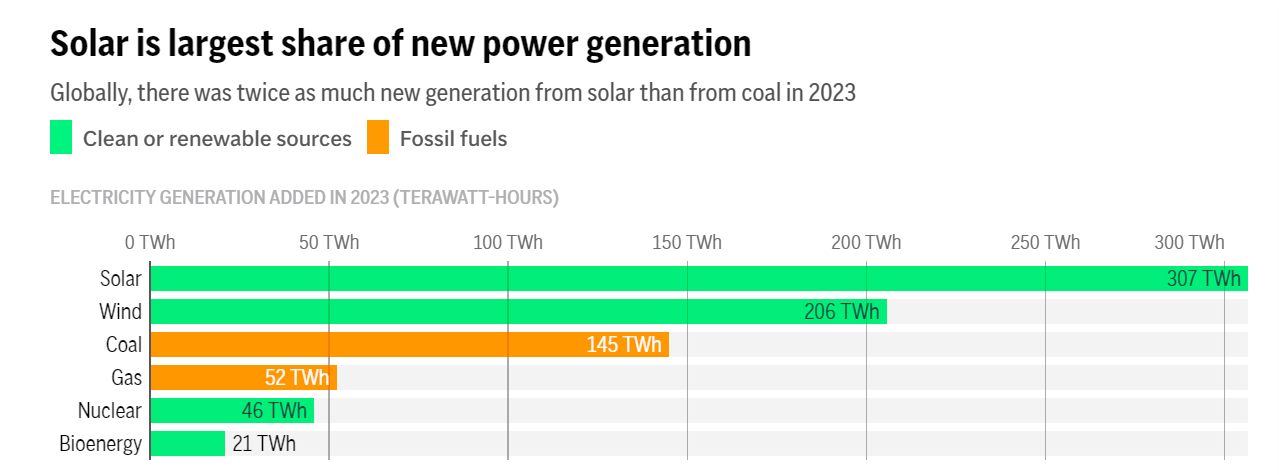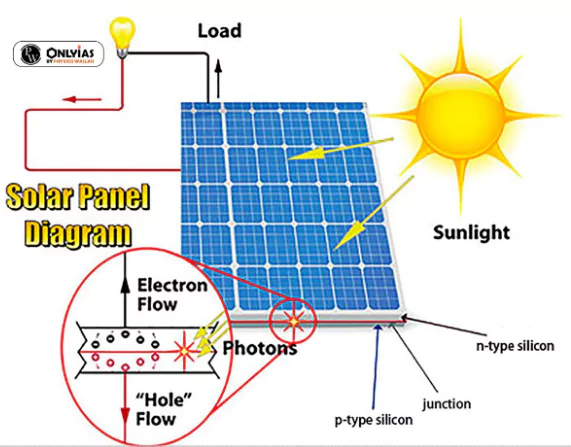Context
According to the report, Global Electricity Review 2024 by international energy analytics agency Ember, India overtook Japan to become the world’s third-highest producer of solar power in 2023.
Key Highlights from the Global Electricity Review 2024 Report
- Leading Solar Power Producers: The leading producer of solar power in the world is China which produced 584 BU of solar power in 2024.
 China is followed by the United States(US).
China is followed by the United States(US).
- Solar Power Generation in India: India generated 113 billion units (BU) of solar power in 2023 compared to Japan’s 110 BU.
- Generation in 2023 was 17 times larger than in 2015 (6.6 BU).
- Rank in Terms of Installed Power Capacity: In terms of installed power capacity, including renewable and non-renewable energy sources, India at 73 gigawatt (1 GW is one billion watts) ranks fifth in the world while Japan is at third place (83 GW).
- Decline in Power Demand in Japan: In 2023, Japan experienced a 2% (2 BU) decline in power demand following consecutive increases in 2021 and 2022, enabling India to surpass Japan.
- The sustainability of this trend in the following year remains uncertain.
- India’s Quest to Surpass the United States in Solar Production: To surpass the United States, currently in second place, India would need to double its current solar production and exceed 228 BU.
 Discrepancy Between Potential and Realized Output: According to data from NITI Ayog, solar energy constituted 18% of India’s total installed electricity capacity of 442 GW as of May 2024.
Discrepancy Between Potential and Realized Output: According to data from NITI Ayog, solar energy constituted 18% of India’s total installed electricity capacity of 442 GW as of May 2024. -
- However, it accounted for only 6.66% of the actual power generated, highlighting the disparity between potential and realized output.
- Carbon Intensive Electricity Generation in India: India’s electricity generation is more carbon-intensive (713 gCO2 per kWh) than the global average (480 gCO2/kWh), with coal accounting for three-quarters of generation in 2023.
- However, India’s per capita emissions from the power sector are just half the global average (1.0 tCO2 vs. 1.8 tCO2) and even below the average in Asia (2.1 tCO2). They are also the fourth lowest in the G20.
- Coal accounted for the largest rise since 2000, increasing by nearly four times (+1,090 BU) from 390 BU in 2000 to 1,480 BU in 2023.
- Rise in Coal Share: The share of coal generation increased from 68% in 2000 to 75% in 2023. Generation from gas and from other fossil fuels declined.
- In 2000, wind and solar accounted for only 0.3% of India’s power generation, but jumped to 9.9% in 2023.
Enroll now for UPSC Online Course
Solar Power
Solar power is energy from the sun that is converted into thermal or electrical energy.

- Technology: It is done either through photovoltaic (PV) panels or through mirrors that concentrate solar radiation (CSP).
- PV cells convert solar radiation (sunlight) into electricity.
- Concentrating Solar Power systems, use concentrated solar radiation as a high temperature energy source to produce electricity.
- Cleanest Renewable Energy: It has been recognized as an alternative to conventional energy resources. It is the cleanest and most abundant renewable energy source available.
Solar Power in India
- Energy Transition Target: India has ambitious plans of sourcing about 500 GW, nearly half its requirement of electricity, from non-fossil fuel sources by 2030.
- At least 280 GW from solar power by that year or at least 40 GW of solar capacity being annually added until 2030.
 Incident Solar Energy in India: The energy of about 5,000 trillion kWh per year is incident over India’s land area with most parts receiving 4 to 7 kWh m-2 per day.
Incident Solar Energy in India: The energy of about 5,000 trillion kWh per year is incident over India’s land area with most parts receiving 4 to 7 kWh m-2 per day. -
- Solar power has a major share in the country’s current renewable energy capacity, which is around 180 GW.
- Share of Rooftop Solar Installed Capacity: It is around 11.08 GW as of December 2023.
- State with Largest Solar Capacity: Rajasthan is at the top with 18.7 GW, followed by Gujarat at the second position with 10.5 GW.
- State with Largest Rooftop Solar Capacity: Gujarat tops the list with 2.8 GW and Maharashtra by 1.7 GW.
Driving Factors Behind Solar Power in India
- Favorable Geography: India is ideally suited for the production of solar power due to its year-round abundance of sunlight.
- India’s land area receives approximately 5,000 trillion kWh of energy annually, with the majority of regions receiving 4–7 kWh per sq m/day.
- Decline in Solar Power Traiffs: The rapid decline in solar power tariffs from 2015 to around 2.5 per kilowatthour (kWh) from nearly Rs 6/kWh has rendered solar tariffs cost-competitive with conventional thermal power.
- Ideally, the availability of competitive solar tariffs should encourage greater adoption of solar energy, thereby influencing clean energy investment decisions in the states.
- Solar Potential: India has an estimated solar power potential of 748.99 GW, indicating that the full potential of solar energy is yet to be harnessed.
- Declining Technology Costs: The cost of renewable energy technologies has been on a downward trajectory, enhancing affordability for businesses and individual consumers alike.
- Growing Energy Demand: India’s robust economic growth translates to rising demand for energy. This demand provides a substantial market for renewable energy investments, encouraging firms to venture into this sector.
- Employment Generation: As the sector expands, more jobs will be generated, offering individuals a chance to contribute to the sustainable energy transition.
Enroll now for UPSC Online Classes
Challenges with Solar Power Generation in India
- Challenges with Roof Top Solar Scheme Implementation:
- Loss Making DISCOMS: According to a December 2023 study conducted by the Centre for Science and Environment (CSE), electricity distribution companies (DISCOMs) were expected to ensure seamless access and connectivity for rooftop solar systems to the national grid.
- Challenges have been encountered in selling excess electricity to the grid due to ineffective partnerships with debt-ridden DISCOMs.
- Slow Progress: India promised to install 40 GW of rooftop solar capacity by 2022 but by the end of 2023, only 11 GW has been installed, including 3 GW in homes with the rest in commercial or industrial properties.
- The goal has now been revised to 100 GW of rooftop solar installations by 2026, 40 GW of which would come from the residential sector alone.
- Non Attainment of RPO Targets: According to government data, there is a shortfall in nearly 25 out of 30 states in meeting their annual solar RPO targets.
| Renewable purchase obligations (RPO): These are mechanisms designed to compel power procurers in every state, like DISCOMS, captive power producers and open-access consumers, to annually purchase a certain minimum amount of renewable energy. |
- Huge Import Dependency: India heavily relies on imports to meet its demand for solar cells and modules. China and Vietnam are the primary suppliers of these products.
- Over the past five years, India imported around $11.17 billion worth of these products which amounts to around 0.4% of India’s total exports during the same period.
- Lower Manufacturing Capacity in India: India’s domestic manufacturing capacity is significantly lower compared to China, and it’s primarily focused on the final stage (modules) rather than the entire production process.
- China supplies 53% of India’s solar cell imports and 63% of solar PV module imports.
- Inadequate Grid Infrastructure India’s current grid infrastructure was designed to support conventional fossil fuel-based power generation, which is more predictable and reliable.
- Ex- Plan to build huge solar plants in Leh was recently canceled due to a lack of transmission infrastructure.
- Intermittency: This is posing a challenge in matching supply with steady demand, especially during evening peak periods.
- The intermittency of renewable energy creates imbalances in the grid, which results in energy waste, grid instability, and reliance on backup power sources.
- Adverse weather conditions like heat waves and storms can hamper the power supply and cause blackouts.
- Decreasing Solar Potential: A study published in the Journal ‘Mausam’ by India Meteorological Department has revealed a significantly decreasing trend in solar power generation potential in the country due to increased aerosol load.
- Causative factors behind increased aerosol load include fine particles from carbon emissions, fossil fuel burning and dust and clouding.
- Aerosols absorb the sunlight and deflect it away from the ground and they can also precipitate the formation of dense clouds that again block sunlight.
- Solar Waste: According to the Ministry of New and Renewable Energy, India’s existing installed capacity has produced approximately 100 kilotonnes of waste.
- This waste is projected to increase significantly to 340 kilotonnes by 2030.
- Variable Bright Sunshine Hours (BHS): Annual BHS is high in northwest India & Low in north, north-east and southern peninsular India. BHS has significantly decreased in 75 percent of the selected stations.
- Most of the stations exhibit maximum BHS during the pre-monsoon and minimum during the monsoon season.
Government Initiatives to Promote Solar Power in India
- Global Solar Facility: It is a payment guarantee fund created by ISA to stimulate investments in solar power projects, with a focus on underserved segments and geographies across Africa.
- International Solar Alliance (ISA): It is an intergovernmental organization launched in 2015 India and France during the United Nations Climate Change Conference in Paris.
- Rooftop Solar Programme: The scheme aims to expand India’s rooftop solar installed capacity in the residential sector by providing Central Financial Assistance.
- The programme’s goal is to increase rooftop solar installed capacity to 40 GW by March 2026 and it is currently in its second phase.
- Pradhanmantri Suryodaya Yojana: This scheme aims to equip 1 crore households with rooftop solar panels.
- PM Surya Ghar: Muft Bijli Yojana: It aims to provide free electricity to households in India.
- Suryagram: Modhera” in Gujarat became India’s first Battery Storage and Solar Power based ‘Suryagram’ with round-the-clock Renewable Power Supply.
- PLI scheme: It aims to enhance domestic manufacturing across the entire solar supply chain, from polysilicon to solar modules.
- Other Measures:
- Permitting Foreign Direct Investment (FDI) up to 100 percent under the automatic route,
- Waiver of Inter State Transmission System (ISTS) charges for inter-state sale of solar and wind power for projects to be commissioned by 30th June 2025.
- Notification of standards for deployment of solar photovoltaic system/devices.
|
Way Forward
- Manage Solar Waste:
- Database Maintenance: Policymakers need to maintain a comprehensive database of installed solar capacity to estimate future solar waste accurately.
- Incentivizing Recyclers: Policymakers should provide incentives to recyclers to encourage effective management of growing solar waste.
- Creating a Market for Solar Recycling: India needs to focus on establishing a market for solar recycling.
Enroll now for UPSC Online Course
- Aligning Solar Installations with RPO Targets: With the implementation of new RPO targets from 2024, the pace of solar installations must align with commensurate RPO trajectories, and any deficits must be procured through the renewable energy certificate (REC) mechanism.
- Revamping of Grid Infrastructure: The grid infrastructure requires a revamp to accommodate the fluctuating and intermittent nature of power from renewables.
- With a high level of electrification, grid infrastructure should be developed on priority.
- A well-connected national grid that transcends several regions ensures optimal utilization of uneven distribution of energy sources.
- Bundling Energy Storage with Generation: Bundling energy storage with generation to create a more stable electricity generation unit, resembling traditional non-intermittent generators.
- Pumped hydro storage (PHS) projects and battery energy storage systems (BESS) are promising energy storage technologies that can play a crucial role in grid-balancing services.
- Structural Reforms: Challenges associated with discoms’ health must be addressed. Implementation of the proposed Electricity Act is crucial for the revival of discoms.
- Direct benefit transfer, discom privatisation, strict RPO compliances and safeguards against contract renegotiation are urgently needed to hasten renewable capacity addition.
- Understanding Solar Power Variations: Understanding the variations of solar power potential over the country is essential for the optimum utilization of solar energy in power generation, which demands accurate information of solar radiation and its variations.
- Adequate Skilling & Training Programmes: Large-scale renewable energy projects could have positive employment outcomes at the district level, but they lead to massive employment shifts between sectors at the national level.
- Adequate skilling and training programmes targeting the unskilled and poorer populations are essential.
Also Read: Decline Trend In Solar Power Potential In India: IMD Study
![]() 12 May 2024
12 May 2024
 China is followed by the United States(US).
China is followed by the United States(US). Discrepancy Between Potential and Realized Output: According to data from NITI Ayog, solar energy constituted 18% of India’s total installed electricity capacity of 442 GW as of May 2024.
Discrepancy Between Potential and Realized Output: According to data from NITI Ayog, solar energy constituted 18% of India’s total installed electricity capacity of 442 GW as of May 2024. 
 Incident Solar Energy in India: The energy of about 5,000 trillion kWh per year is incident over India’s land area with most parts receiving 4 to 7 kWh m-2 per day.
Incident Solar Energy in India: The energy of about 5,000 trillion kWh per year is incident over India’s land area with most parts receiving 4 to 7 kWh m-2 per day.